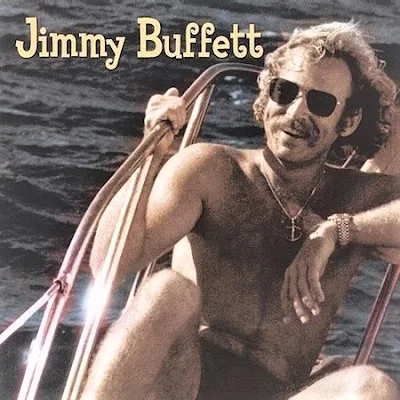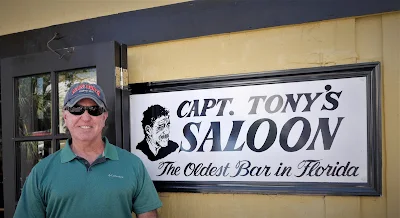 |
| We'll find you, Mr. Jimmy Buffet - in Key West |
In other words, Paradise.
There was such adventure awaiting this dynamic duo, once the plane landed on the tarmac at Miami International Airport.
 |
| Laureen at the Southernmost point on the Continental USA |
The trip may have been cancelled if it had been planned for just a week earlier. That was when the powerful Hurricane Dorian, tore through the Bahamas, leaving behind unspeakable devastation and death. Luckily for the people of Florida, Dorian had turned north-east and only skirted the outer shores of the United States.
With that said, the people of the Bahamas remained in our hearts and prayers as we drove south in search of Jimmy Buffet, the poet, song-writer (and extremely wealthy businessman).
Of course we knew that Jimmy would not be sitting down with a couple of margaritas on a sandy beach on the Gulf of Mexico with us - but in search we went anyway.
Buffet and Key West are synonymous for being unique and resilient. Walking down Duval Street, the main thoroughfare in old Key West, only enhances the wonderful strangeness of the place. There are bars and more bars, stores selling anything and everything, Tarot card readers, and even a brothel, about which the locals only smile and shrug when asked. This part of Key West is about as eclectic as Jimmy Buffet's songs are.
 |
| Duval Street in the evening in Key West |
Key West had made it.
 |
| Some strangely beautiful people in Key West... |
As with Key West, Buffet had also seen times when he wasn't Jimmy Buffet, but simply Jimmy Buffet, a down-on-his-luck singer from Nashville. He had tried his musical talent in that famous, Tennessee city, but after awhile, and with no money in his pockets - plus a divorce - he headed south.
South, would be traveling with his friends Jerry Jeff Walker (of Mr. Bojangles, fame) and Teresa "Murphy" Clark. Jerry and Teresa allowed Jimmy to stay with them at their house in Coconut Grove in Miami.
But soon, restlessness moved Jimmy further south to Key West. He knew, that perhaps this strangely beautiful area, and it's equally strangely beautiful people would understand his music and lyrics.
Nashville hadn't - so what did he have to lose?
In the early 1970's he lived in a little apartment next to a place called, Louie's Backyard, a bar and restaurant.
We visited the place, had a beer or two while looking over the ocean and didn't realize where we were actually sitting. Then we heard the bartender - we like bartenders - telling a story when a certain song came out and people started visiting the bar and 'stealing' items. Anything, so they could tell their friends, they had some memorabilia linked to Jimmy Buffet.
In 1974, Jimmy's album, Trying To Reason With Hurricane Season, talked about Louie's Backyard.
'God, I slept way past noon, Stood up and tried to focus, I hoped I wouldn't have to look far, I knew I could use a Bloody Mary, So I stumbled next door to the bar.'
"I actually had to chase two guys down the beach who stole a full size lounge chair." she told us.
"Why not the whole bar?"
"It was too heavy and bolted to the floor, I guess," she replied.
 |
| First place Jimmy Buffet played in Key West - for beers only! |
He played for beers. Wow! For beers - the guy is worth over a half-a-billion dollars now. Gotta love the opportunities the good old United States offers a down and out singer from the 70's.
Along with Jim Croce, Vaughn Cochran, and others, Jimmy hit his stride and the rest is history for this musical icon.
Changes in Latitudes, Changes in Attitudes, his 6th album released in 1977, made it into mainstream audiences and his career took off.
But, unlike many up and coming musical artists - Jimmy was business savvy. He began marketing islander styled clothing, posters, and then opened his first Margaritaville in Key West.
 |
| Laureen, pointing out where Margaritville started in Key West |
From there, the money kept pouring in - but he never forgot his roots.
In 1985, his album Last Mango in Paris, hit the charts and one song spoke (he's a poet and he knows it) about Captain Tony's Saloon on Green Street.
 |
| John in front of - hmmm, a bar - very strange |
Even though Jimmy moved to Palm Beach around 1992, he kept his house in Key West until 1998, when he sold it for over a million dollars. He was a smart guy with the bucks!
So, we found the early Jimmy Buffet in Key West - walking the streets and alleys of this town let us realize the draw it had on a young singer. It has the same appeal to these travelers. A place where a person can be who they are - challenge themselves - and prove they have the grit to succeed with their dreams no matter the setbacks.
Jimmy Buffet, along with many others, have made this key their home and not only found themselves, but their fortunes as well.
If it wasn't for the bloody hurricanes and humidity!
Our search was over - on to the next one.
 |
| Who's next on the list to search for in the Florida Keys? |


















